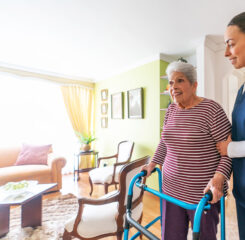Most Frequently Cited F-tags of 2022 – Part 2
Annual surveys are back on the books for nursing homes, as state survey agencies (SAAs) are checking off backlogs from the last 24 months of the pandemic. To help members prepare for survey readiness, LeadingAge analyzed the top ten (10) frequently cited deficiencies from January 2022 to present. In this article, we review six through ten frequently cited F-Tags. Read about tags one through five here. There were no major surprises but as LeadingAge drilled down to the findings on 2567s, we found common areas of non-compliance cited that your nursing home can incorporate in mock surveys, rounds and performance improvement plans
The sixth frequently cited F-Tag is F677 ADL Care for Dependent Residents. The intent of this tag reviews the ADL care needed for dependent residents such as eating, toileting, bathing, dressing, grooming, ambulating and transferring. Each ADL has components that could led to non-compliance if the care is not received according to standards, care plan and resident choice and preference.
TIP: F677 was cited to providers for focused areas of grooming. Staff know the ADLs and what is needed to care for their residents but take a closer look. Are nails trimmed and clean? What about facial hair, neat and combed on men and don’t forget women, unnecessary facial hair. How does the resident like to wear their hair or any makeup? Another check would be for bathing. Does the resident prefer a bath or shower? Look at their bathing record. What was given to the resident? Lastly, don’t forget clothing. Clothing should be free of rips, tears or stains. But is it buttoned correctly or is the zipper working? Does the resident like to have a sweater or blanket with them while in the community?
The seventh F-Tag is F761 Label/Store Drugs – Biologicals. For the last year, this tag has crept into the top 10 and has made a place for a quick non-compliance leading to deficiencies.
TIP: Depending on the storage of the community’s medication, this F-Tag may be cited from the medication carts or the medication room. Check to make sure all medications are labeled properly, the resident name, expiration date – follow professional standards. What about storage, is the medication stored according to the right temperature, light or humidity? Does the medication need to be in a secure, locked area? The intent of the F-tag is to ensure there are not medication errors – wrong labeling and not following professional standards and manufacturing guidelines could led to a deficiency or worse a medication error.
The eight frequently cited F Tag is F656 Develop Comprehensive Care Plans. A nursing home must develop and implement a comprehensive person-centered care plan for each resident consistent with resident rights that includes measurable objectives and timeframes to meet the needs identified in the comprehensive assessment.
TIP: Review care plans for measurable objectives as well as history of behaviors of the residents. Is the care plan up to date with resident behaviors and interventions and preferences? Have you reviewed incidents or resident to resident interaction and updated care plans? Take a look at documentation all across shifts. Is there evidence that care plan interventions are being implemented?
Number nine on the top ten is F755 Pharmacy Services/Procedures/Pharmacist Records. With the lockdown over the past few years,, pharmacy consultants were unable to be in the nursing home working on pharmacy services. LeadingAge analysis of 2567 has shown that there needs to be a few quick performance improvement projects focused on pharmacy services.
TIP: Have the Administrator review the pharmacy contract for deliverables. Are there in-services that need to be performed? Is the pharmacy consultant attending the QI meeting and providing reports? What are the outcomes of the medication station IDs during rounds? What about the pharmacist signing off on records or reports? Lastly, take an inventory of the pharmacy procedures and are they being followed?
Last but not least number ten is F F686 Treatment/Services to Prevent/Heal Pressure Ulcer. A frequent F- tag for years, nursing homes need to stay vigilant in communication and documentation of pressure ulcers at all stages.
TIP: Pressure ulcers may be acquired in house on residents, but the documentation is the key to help reduce any non-compliance and further deficiencies. What is the process for identifying a pressure ulcer? Do all staff know who to report any changes in skin? Is there a documentation tool? Does the attending physician have a role? Have you reviewed the care plan or updated to treatment. CMS has informed LeadingAge that pressure ulcers are increasing in nursing homes. Have you reviewed your turning and positioning program? Take a look behind ears, the mask elastic is causing irritation and rubbing on the skin No matter a Stage 1 or a Stage 4, care, treatment and documentation done properly is the key to avoiding this F tag.

Most Recommended
October 15, 2025
 Shutdown Week Three: Impact of Ongoing Closure on Affordable Housing
Shutdown Week Three: Impact of Ongoing Closure on Affordable Housing
December 10, 2025
Fiscal Year (FY) Funding 2026
October 07, 2025
Immigrant Workforce Matching Program Brings Workforce Relief
Recently Added
December 29, 2025
 RHT Program Awards: All 50 States To Receive Funds, Says CMS
RHT Program Awards: All 50 States To Receive Funds, Says CMS
December 29, 2025
 CMS Publishes Draft OASIS-E2 Guidance Manual
CMS Publishes Draft OASIS-E2 Guidance Manual
December 23, 2025
 CMS Debuts Models: ACCESS, ELEVATE and LEAD
CMS Debuts Models: ACCESS, ELEVATE and LEAD
December 22, 2025



